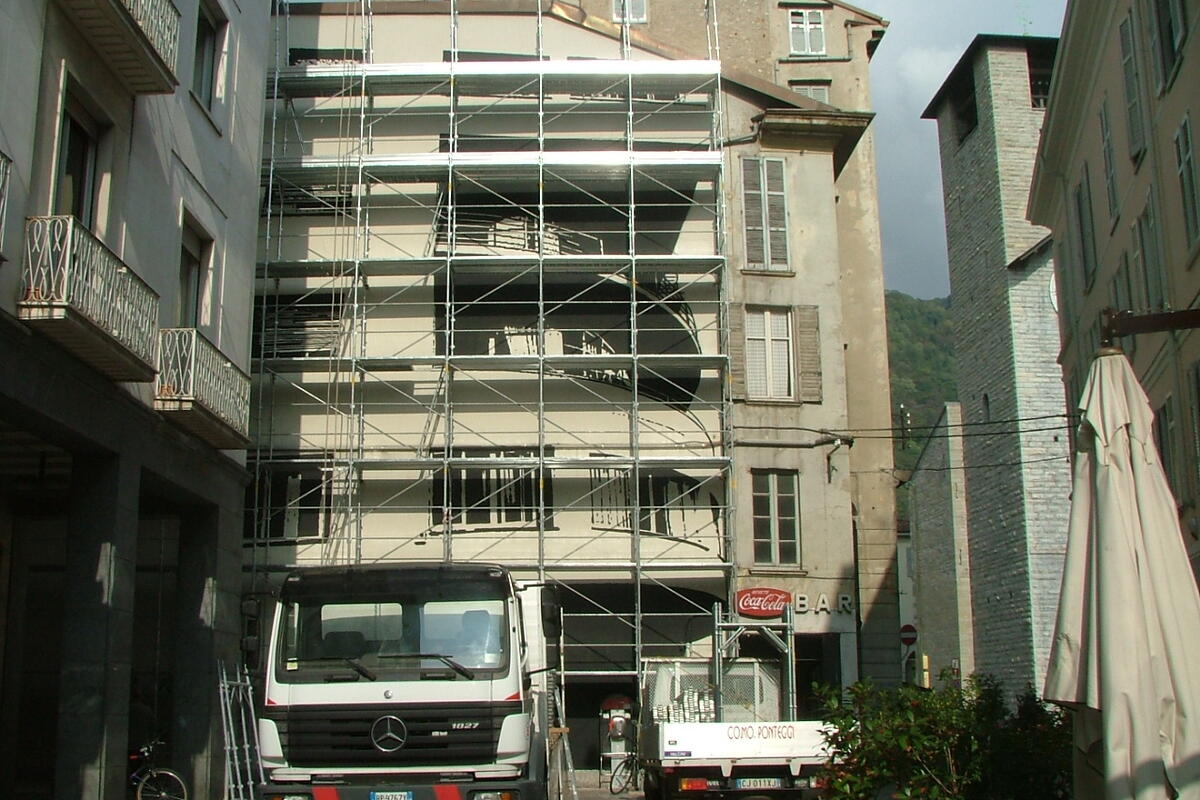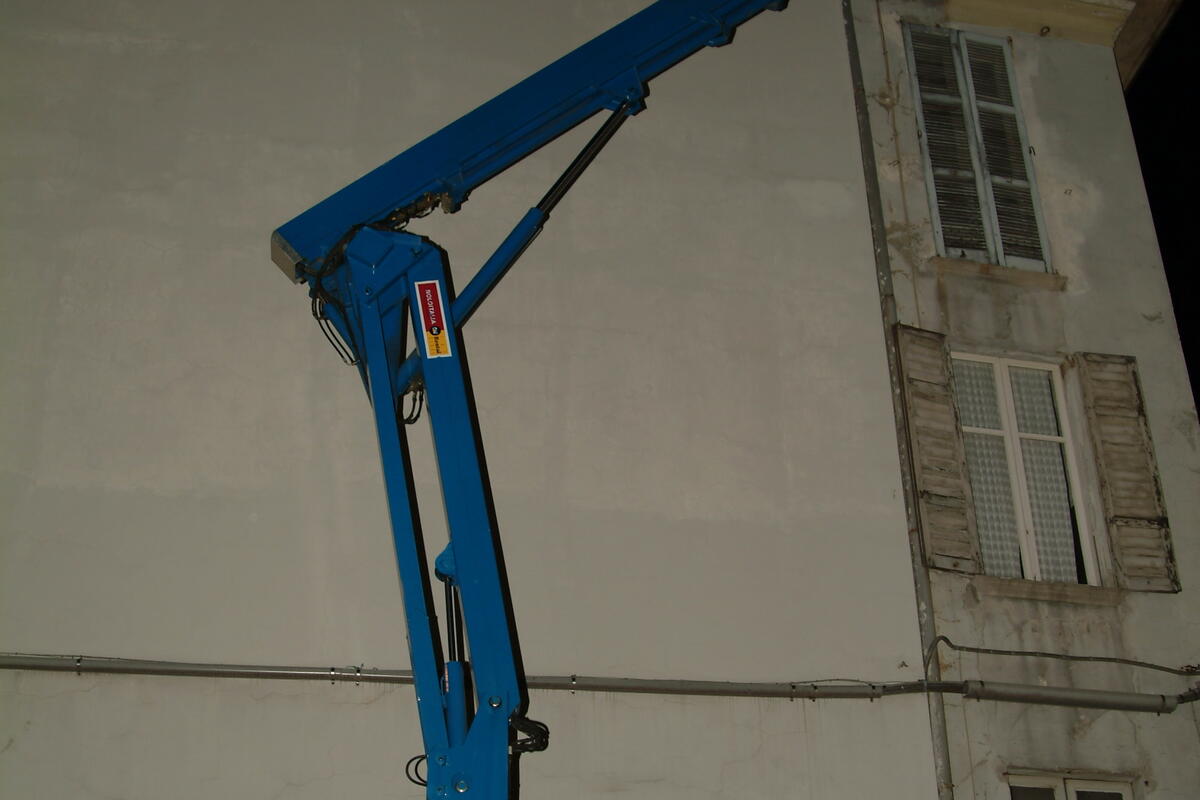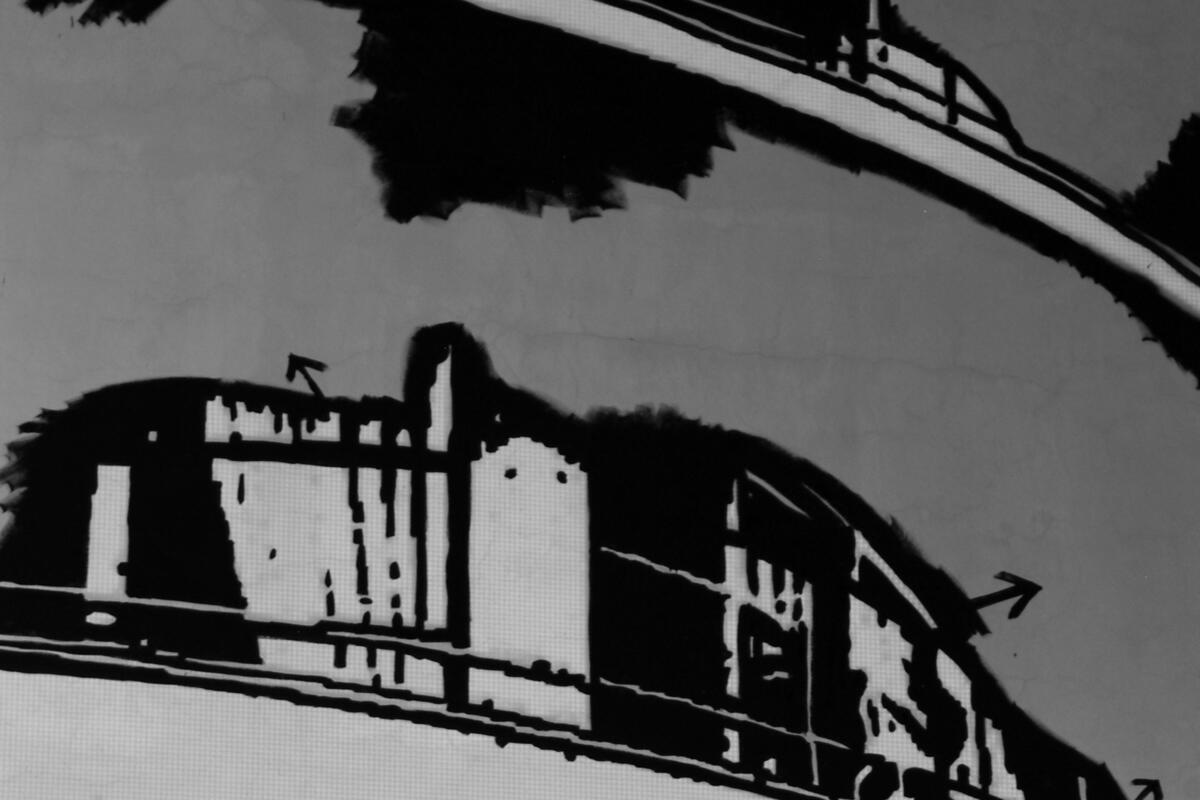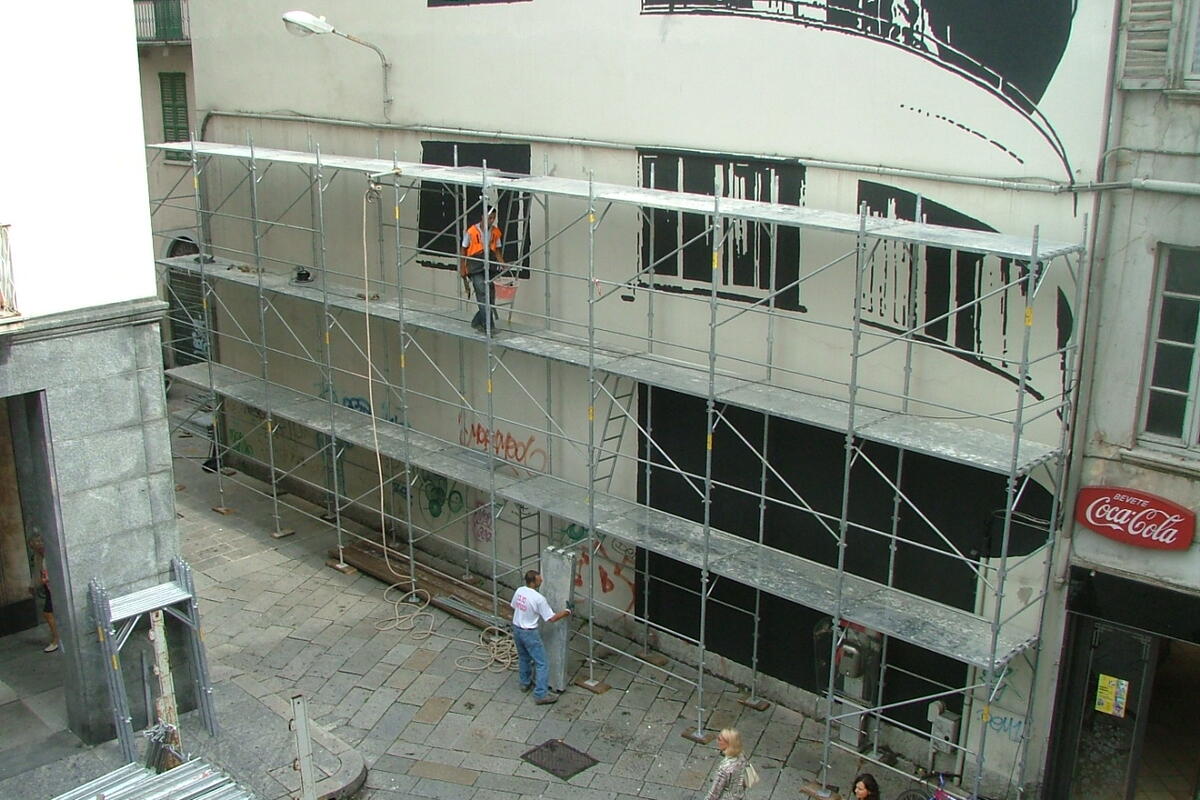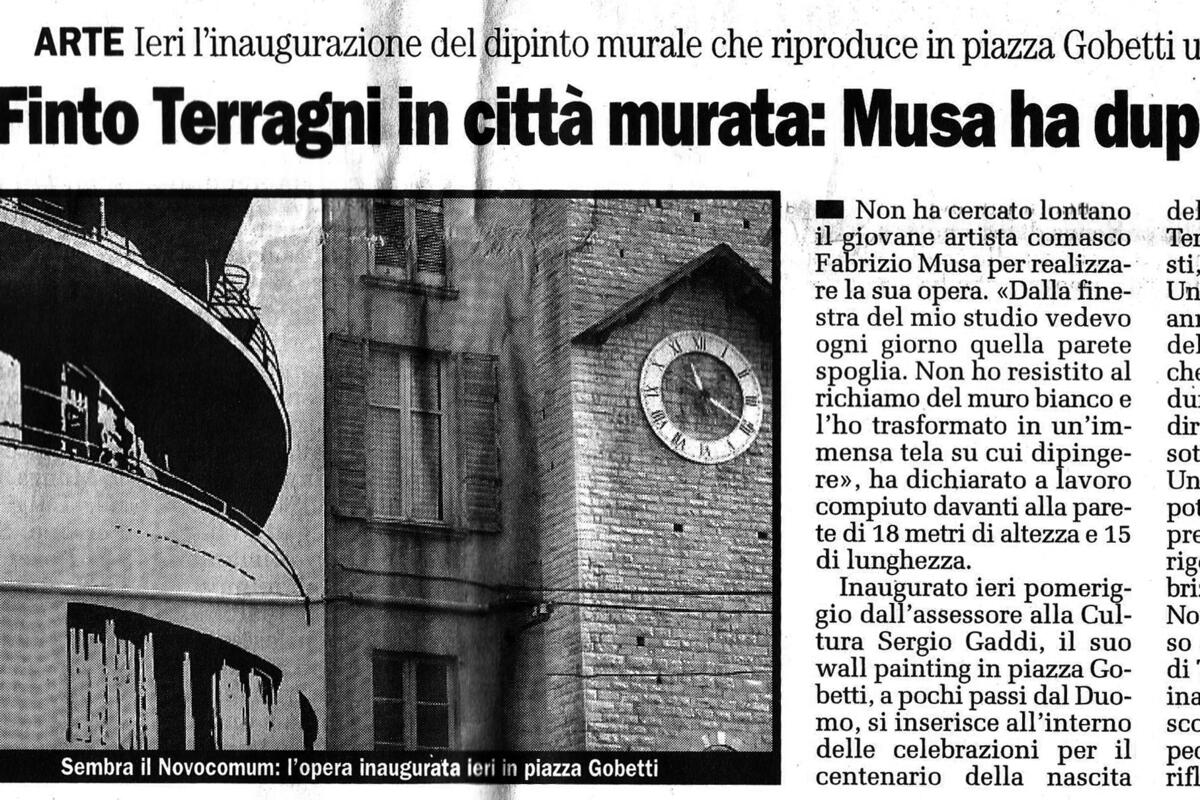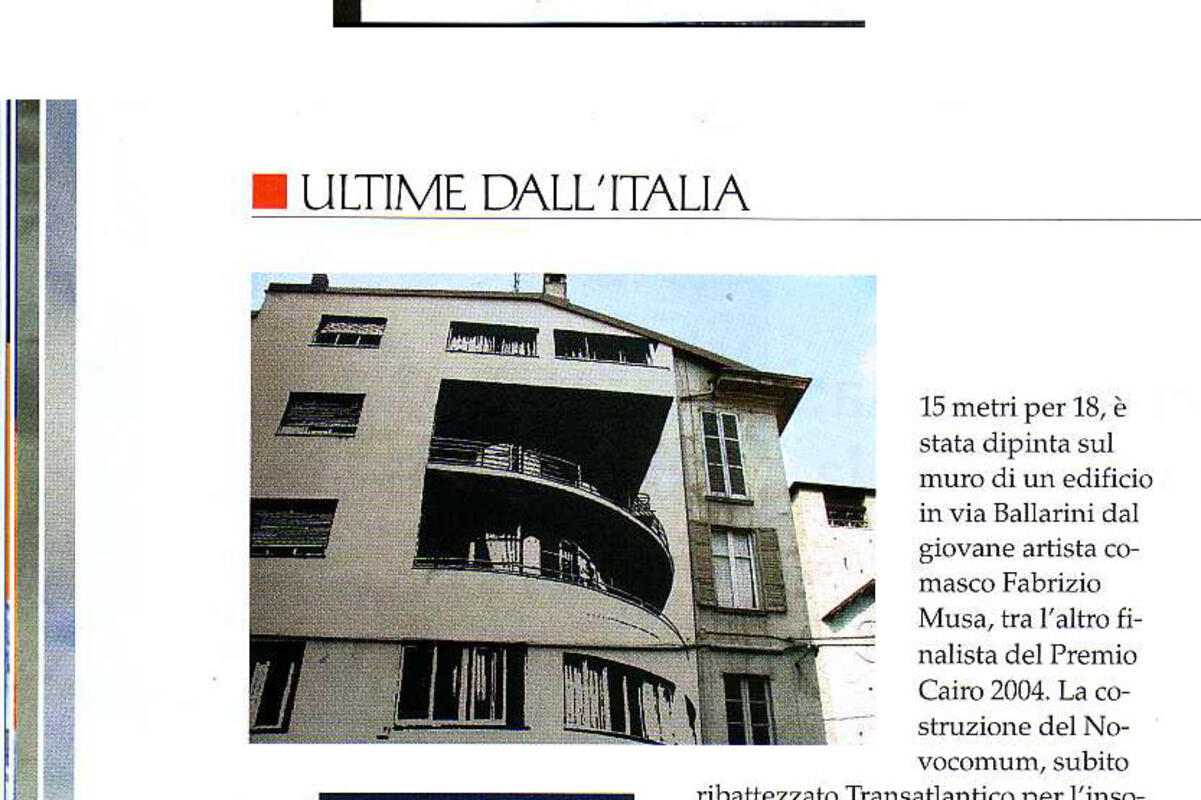COMO _ WALL PAINT PUBLIC PERMANENT WORK "NOVOCOMUM XXL.TXT"
THINKING BIG
How should we celebrate the work and the figure of a modern architect? Up till today, by putting on a single monographic exhibition of his work with a catalogue, prepared thanks to the assistance of a few specialized critics.
For GT04, on the other hand, celebrating means expressing our simultaneousness with the works of the past.
A prototype made up of exhibition belonging to every sphere of art and in which all citizens have the right to take an active part. Como in 2004 has become a laboratory for the celebration of Giuseppe Terragni and as we walk through the town we come up against signs of experimentation, programmed and spontaneous. A few steps from the Cathedral, for example, the work of Fabrizio Musa unveils to us a fascinating form of simultaneity with a vision of Giuseppe Terragni.
Musa's artistic performance has its origins, in fact, in a photomontage by Giuseppe Terragni. In the monographic issue of "Quadrante" on the Casa del Fascio there is an image/collage in which the outline of the Novocomum is silhouetted against the image of the Cathedral, thus confronting three ages: the Cathedral of the Como masters, the dome by Juvarra and the modern Novocomum. As if dreaming of this photomontage, Musa's wall painting miraculously makes the idea available to all citizens. From one of the point of the city where the vision of the dome is at its most extraordinary, the image of the Novocomum realized by Musa is still perfectly able to commune, for us, with the imperturbable presence of the Cathedral.
And a modern image in the center of the historical part of the city is a kind of victory over the vacuum which has for too long surrounded the monuments of the past. This appearance, this surprising "outsider", obtains for us a victory over the historical distance imposed by the "specialists" between us and the city's monuments and offers us a surprise which reflects the massive presence of time and the abundant presence of special, complex and differentiating themes of which the history of a finally European Como should be formed. Creating a work that can rival with the ancient world and not be merely its reflection but almost its double is a way of looking at history with which Giuseppe Terragni had characterized the Italian way of viewing modernity. Placing new architecture alongside old is not giving space to the vague and uncertain but to disproportion, and implies a positive outlook too often neglected: it lets us think big.
Attilio Terragni
REDEFINING THE CONTEXT
More than a murales, or an unusual trompe l'oeil, what Fabrizio Musa has realized on a wall in the historical center of Como is a painting. This apparently obvious remark implies an awareness which is by no means obvious: painting, before being an expressive technique, or one artistic genre among way, is a dimension which is able to extend, subvert and reinvent our relationship with reality. A painted image, when it possesses sufficient intensity to attract attention, insinuates itself so completely into the spectator's gaze as to redefine his visual parameters, his modes of perception, the instruments with which he approaches reality.
Looking at this most recent, imposing work by Fabrizio Musa I am reminded of the celebrated oriental anecdote which tells how a Chinese Emperor one day asked his first court painter to erase the waterfall which he had frescoed on the wall of his palace, because the noise of the water kept him from sleeping.
I hope that nobody will ever ask the artist to cancel his colossal work; but in this image, too, as in that realized by the Chinese painter, there is a presence that goes beyond representation, an unexpected movement enfolds and partly stirs the observer.
Perhaps Musa chose to paint the Novocomum on account of the unexpected circular dynamism which characterizes the building, and which the painting further emphasizes.
Certainly, the architectural original and its pictorial copy possess the same capacity to generate wonder, the same ability to amaze even the most casual onlooker and – through this amazement – to invite him to reconsider the context in which both the work and the object to which it refers are placed.
Fabrizio Musa's painting celebrates Terragni in many ways, but in one in particular. Being onlya short distance from the Cortesella area, it recalls at least ideally the figure of the great architect on the threshold of a part of the city which could have received an important contribution from him.
The circumstances of the failure to redevelop the Cortesella area under Terragni's direction represent one of the many missed opportunities to rethink boldly Como's urban structure.
All things considered the realization of this fresco induces us to hope that this might yet be done.
In transforming a bare, empty wall into an immense painting, Fabrizio Musa has shown that art is the most suitable instrument for repeating the aesthetic lacunas of the territory. The contribution of painting, in this case, has not only redefined the formal content of the city, but has also shown that even the substantial context can be radically changed.
Roberto Borghi
CONVERSATION WITH FABRIZIO MUSA
Carlo Ghielmetti: I've put myself in the shoes of the common onlooker. By that I mean, the shoes of someone who while passing, absent-mindedly or deliberately, in front of your wall painting, stops and, after a few moments of amazement, wonders why this mural was made, why it has that subject and why it is there, on that blind wall a few steps from the Cathedral.
Fabrizio Musa: It would be too easy to reply with a phrase of Le Courbusier's that "I was born to look at images and to draw". In reality, I think there was that component that I call "the unconscious innate", or rather, I was helped by the fact that I am from Como, I always have lived in Como, in visual, physical and spiritual contact with the architecture of Giuseppe Terragni, from the earliest years of my childhood.
CG: I agree, and I also agree that the opening of the celebrations of the centenary of Terragni's birth was an element which stimulated your artistic creation, but I'm also convinced there's more to it than that. For example, why the Novocomum in particular and not another piece of architecture?
FM: The Novocomum is, of all Terragni's pieces of architecture the one which has most intrigued me, interested ,e, aroused my curiosity. I have seen it again and again…studied it. I have never missed an opportunity to pass alongside it and, whenever possible to enter this enormous building which gave me at the same time the idea of great solidity, but also of great lightness. For a painter like me, too, its forms were too strong an attraction to be able to remain insensible to it.
CG: From what you're telling me, though, I get the idea that there is at the back of all your work a study, including a theoretical one, of Rationalism. With this in mind, I'm sure you are well aware of the photo montage that appeared in the magazine "Quadrante", where the architectural forms of the Cathedral of Como, the chapel of Juvarra and the Novocomum itself were superimposed.
FM: I certainly am. I can say that the photomontage was my starting point.
CG: Can you explain this more?
FM: My intention was to bring a piece of modern architecture, as important as those of Terragni, back to the historical center of Como, within the city walls. That of the Novocomum seemed to me from the beginning the most suitable, in part so as to reproduce the image of the photomontage, but above all so as to create a line of continuity between this building, "virtually" reconstructed, the Cathedral, its dome and the Casa del Fascio which is only about a hundred centimetres beyond it.
CG: Is this perhaps the reason why you didn't use the image of the Monument to the Fallen which in its form, with its vertical development, would have been simpler to represent?
FM: It isn't just a formal problem, also because what I have painted is in reality only a detail of the building, on which I have played with the perspectives. But I liked the idea of painting a house on a house, trying in this way to relate the stories and the lives that have taken place in these two houses.
CG: Speaking of perspective, however, I seem to gather that one of the merits of your wall painting is precisely the fact that it can be seen from different angles, each of which retains its own suggestiveness.
FM: This is true; with regard to this work of mine, I use the phrase "disorienting perspective". I have played with an exaggeration of vision. Or rather, the perspective from which I started is taken from the bottom to the top. On the other hand, I have never stopped thinking of these walls as an immense canvas and so it must be possible to view it correctly even at a distance of 30...40...50 meters, just as you do with pictures in a room.
CG: And not only that…the wall also looks out on a small street, causing a view like a trompe l'oeil.
FM: That's true, arriving from Piazza Gobetti the wall seems to inflate...it seems to create a paunch that straightens up and disappears when you get closer.
Carlo Ghielmetti
NOVOCOMUM XXL TXT
Giuseppe Terragni's Novocomum takes on a surprising appearance in the city center. A work of urban transformation that a single stroke brings us closer to a hundred years of history, stirs up the roots of the city's habits and gives a new meaning to the simple wall of a civil building. And becomes a work of art in the fullest and truest sense, a work that lives thanks to the product of Terragni's genius and the post-contemporary vision of Fabrizio Musa, one of Como's most promising artists with a series of important experiences and international recognitions behind him.
The digitalised language of Musa's scanner art duplicates the revolutionary architecture of the master of rationalism in an extension of meaning which becomes a part of the city's patrimony.
It is for this reason that the Comune of Como has decided to adopt the idea of the young artist and to produce directly thanks also to the enlightened willingness of the owners of the building and the help of private energies, this enormous mural as a sign of homage to the great architect in the first centenary of his birth.
A work that will be able to live and to remain as part of the fabric of the identity of our city which, more than any other in the world, is the custodian of Terragni's architectural patrimony and which has wished to celebrate 2004 worthily with a series of exhibitions and international cultural events.
Como has chosen firmly the path of cultural investment as a strategic factor for its future development, the idea of aiming to become more and more a creative laboratory for the elaboration of trends is a challenge which is launched against the international horizons of painting, photography, sculpture, décor and urban revision. Musa's great mural questions the language of the symbol, forming a relationship with the timeless modernity of a still living architectural vision and managing to escape from the logic of the particular and the contingent in order to convey to everyone the full sense of the planned project.
A bold experiment, therefore, by a contemporary artist armed with the technological instruments of today who has been able to enter into a direct relationship with Giuseppe Terragni and who has succeeded in communing with the modernity of the extraordinarily strong and contemporary lines of Novocomum.
Sergio Gaddi
Assessore alla cultura del Comune di Como


